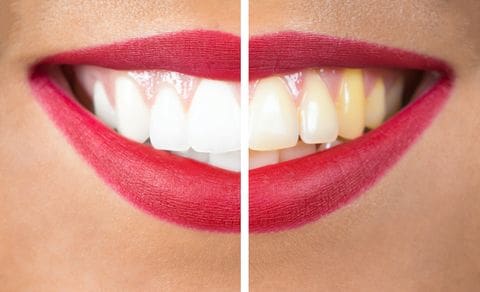Want to keep your smile looking bright and pearly white? Good dental care will keep your teeth strong and healthy and better able to resist potential staining. You can also discuss teeth whitening options with your cosmetic dentist that can enhance the color of your smile.
But if you do form disruptive stains on your teeth, you might realize that not all tooth stains are the same. Teeth can become discolored in multiple ways and for many reasons.
These differences can affect the type of treatment you may need to amend these aesthetic concerns in your smile. Learn about four types of dental discoloration you might develop on your smile and what they can mean for your oral health when you read on.

Dark Dental Stains
If you see brown or black spots on your teeth, they can appear stark and highly noticeable in your smile. In many cases, this specific dental discoloration will come from substances you consume. For instance, dark-colored foods and beverages, like red wine and coffee, will transfer particles to your teeth as you eat or drink them.
These substances will absorb into the tooth enamel to make dark stains that your toothbrush cannot remove. A dentist will need to use bleaching treatments to lift and dissolve these stains.
Dark tooth stains will also form as a side effect of tooth decay though. So to ensure you get the treatment you need, do not ignore this discoloration. Book a dental evaluation to treat decay and enhance your smile’s appearance.
Yellow Tooth Color
If your teeth start to look yellow in color, this might happen due to staining agents in items you consume too. But yellowing teeth may also occur if you suffer from enamel erosion.
The enamel, the outer shell of your tooth, is strong, and built to withstand wear and tear from chewing and biting. But under extreme circumstances, enamel may begin to erode. Acidic diets, bruxism, and poor oral hygiene might all cause dental erosion.
When enamel thins and reveals the underlying dentin layer of your teeth, it can look yellow. A weak dental structure might face a greater risk of tooth decay and other issues, so do not dismiss the problem. Enamel will not regenerate on its own, so you will need to work with your dentist to restore your dental health.
Grey or Dull Teeth
A dull or grey tooth color might happen due to internal damage within a tooth. The pulp, the center of the tooth, contains blood vessels that keep it vital and healthy. Impact trauma to the face might injure the tooth’s interior.
If blood cannot flow properly to the tooth’s pulp, it can become non-vital. This results in a greyish color. While not always a dental emergency, a non-vital tooth pulp can have a greater chance of contracting an infection.
A dentist will want to monitor this tooth more closely. Plus, you might want to find cosmetic dental treatment to make the tooth brighter and whiter.
White Dental Discoloration
Although you may look forward to a pearly white finish in your tooth color, you might form creamy white spots on the surface of the teeth that stand out against your natural tooth color. This is a sign of a lack of calcium in the teeth, a type of weakening of the tooth enamel.
Your dentist can help you find ways to remineralize your teeth and restore the strength of your smile. You might need porcelain veneers or another smile enhancement treatment to even out your tooth color though.
